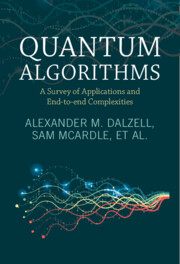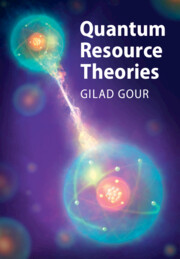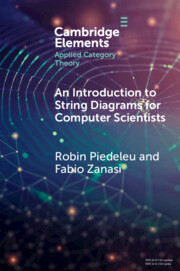Refine search
Actions for selected content:
48571 results in Computer Science

Quantum Algorithms
- A Survey of Applications and End-to-end Complexities
-
- Published online:
- 03 May 2025
- Print publication:
- 24 April 2025
-
- Book
-
- You have access
- Open access
- Export citation

Quantum Resource Theories
-
- Published online:
- 03 May 2025
- Print publication:
- 10 April 2025

Digital Behavior
- Evidence-Based Digital Design
-
- Published online:
- 03 May 2025
- Print publication:
- 06 February 2025
Methods as a form of engineering knowledge
-
- Journal:
- Design Science / Volume 11 / 2025
- Published online by Cambridge University Press:
- 02 May 2025, e12
-
- Article
-
- You have access
- Open access
- HTML
- Export citation

An Introduction to String Diagrams for Computer Scientists
-
- Published online:
- 01 May 2025
- Print publication:
- 29 May 2025
-
- Element
-
- You have access
- Open access
- HTML
- Export citation
Index
-
- Book:
- Probabilistic Data-Driven Modeling
- Published online:
- 17 May 2025
- Print publication:
- 01 May 2025, pp 429-432
-
- Chapter
- Export citation
16 - Time Series and Probabilistic Modeling of Evolving Processes at Different Timescales
- from Part III - Model Construction from Data
-
- Book:
- Probabilistic Data-Driven Modeling
- Published online:
- 17 May 2025
- Print publication:
- 01 May 2025, pp 301-328
-
- Chapter
- Export citation
7 - Entropies
- from Part II - Foundations of Probabilistic Modeling
-
- Book:
- Probabilistic Data-Driven Modeling
- Published online:
- 17 May 2025
- Print publication:
- 01 May 2025, pp 99-112
-
- Chapter
- Export citation
Appendix F - Expectation Maximization
-
- Book:
- Probabilistic Data-Driven Modeling
- Published online:
- 17 May 2025
- Print publication:
- 01 May 2025, pp 410-414
-
- Chapter
- Export citation
Appendix G - Bad Modeling
-
- Book:
- Probabilistic Data-Driven Modeling
- Published online:
- 17 May 2025
- Print publication:
- 01 May 2025, pp 415-418
-
- Chapter
- Export citation
Part I - Preliminaries
-
- Book:
- Probabilistic Data-Driven Modeling
- Published online:
- 17 May 2025
- Print publication:
- 01 May 2025, pp 1-2
-
- Chapter
- Export citation
Contents
-
- Book:
- Probabilistic Data-Driven Modeling
- Published online:
- 17 May 2025
- Print publication:
- 01 May 2025, pp vii-xii
-
- Chapter
- Export citation
References
-
- Book:
- Probabilistic Data-Driven Modeling
- Published online:
- 17 May 2025
- Print publication:
- 01 May 2025, pp 419-428
-
- Chapter
- Export citation
6 - Multivariate Probabilities
- from Part II - Foundations of Probabilistic Modeling
-
- Book:
- Probabilistic Data-Driven Modeling
- Published online:
- 17 May 2025
- Print publication:
- 01 May 2025, pp 79-98
-
- Chapter
- Export citation
9 - Stochastic Processes and Scaling Laws
- from Part II - Foundations of Probabilistic Modeling
-
- Book:
- Probabilistic Data-Driven Modeling
- Published online:
- 17 May 2025
- Print publication:
- 01 May 2025, pp 141-166
-
- Chapter
- Export citation
Appendix C - Some Optimization Problems and Methods
-
- Book:
- Probabilistic Data-Driven Modeling
- Published online:
- 17 May 2025
- Print publication:
- 01 May 2025, pp 403-405
-
- Chapter
- Export citation
17 - Construction of Network Representations from Data
- from Part III - Model Construction from Data
-
- Book:
- Probabilistic Data-Driven Modeling
- Published online:
- 17 May 2025
- Print publication:
- 01 May 2025, pp 329-346
-
- Chapter
- Export citation
Appendix A - Essentials on Probability Theory
-
- Book:
- Probabilistic Data-Driven Modeling
- Published online:
- 17 May 2025
- Print publication:
- 01 May 2025, pp 397-400
-
- Chapter
- Export citation
Preface
-
- Book:
- Probabilistic Data-Driven Modeling
- Published online:
- 17 May 2025
- Print publication:
- 01 May 2025, pp xiii-xviii
-
- Chapter
- Export citation
Part II - Foundations of Probabilistic Modeling
-
- Book:
- Probabilistic Data-Driven Modeling
- Published online:
- 17 May 2025
- Print publication:
- 01 May 2025, pp 47-48
-
- Chapter
- Export citation
